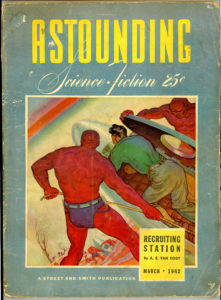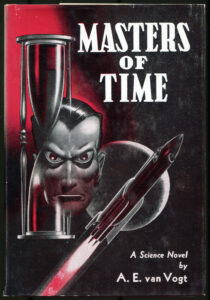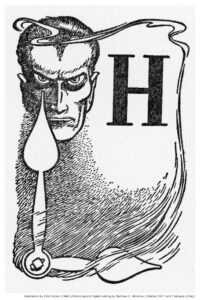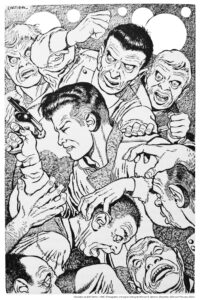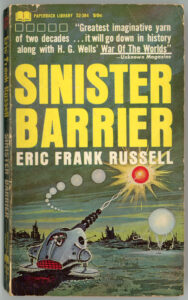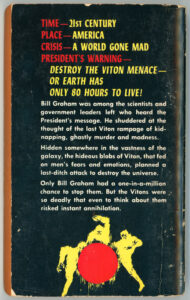“Faster, Will!”
April’s smooth legs clung to his racing body.
She leaned forward, her breasts against his striped coat.
He stretched out his stride, rejoicing in his boundless power.
He exulted in the clean chill of the air, the warm burden of the girl.
This was life.
April Bell had awakened him out of a cold, walking death.
Remembering his body, that frail and ugly husk he had left sleeping in his room,
he shuddered as he ran.
“Faster!” urged the girl. “We must catch them on Sardis Hill.”

I’ve not yet read Darker Than You Think, but in time I well may, for it seems that my literary tastes are gently but steadily changing. To my own surprise, it seems that I’ve acquired an appreciation for fantasy by having read Poul Anderson’s wonderfully told two-part tale, “Three Hearts and Three Lions”, from the September and October ’53 issues of The Magazine of Fantasy and Science Fiction, and, the collection of Robert Chambers’ tales, The King in Yellow…
Darker Than You Think? The novel has received high praise in terms of plot and pacing. It’s a fantasy, but not purely fantasy. It has elements of science fiction, but it’s not entirely science fiction. Instead, it spans the tenuous and uncertain borderland between both genres, combining elements of both, with a foundation in myth and the supernatural: legends of lycanthropy. Of course, for me, the very fact that novel was penned by Jack Williamson casts it within a glowing – well, a potentially glowing! – light beforehand.
So, I suppose that in time, I shall see.
Thus for the novel’s literary “image”. What about illustrations within the novel, or, to be accurate, “on” and in its first book-form incarnation by Fantasy Press in 1948?
There are only two: The front cover, by A.J. (Andrew Julian) Donnell, and the frontispiece, by Edd Cartier. Each artist depicts, in his own fashion, characters central to the novel (at least I think so, not actually having yet read the story!): April Bell “au natural”, and, Will Barbee, transformed.
Due to the novel’s significance in terms of Jack Williamson’s oeuvre, and, the history of Fantasy Press’, even the most cursory Internet search will yield umpteen images of these two illustrations, at all imaginable levels of quality. You know… Resolution, focus, color reproduction, and just-plain-old-keeping-the-image-framed-properly.
Here’s the cover…

I thought it was time that I take a look and copy the frontispiece for myself. To that end, I recently accessed a copy of the novel – unsurprisingly, in absolutely superb condition – at the New York Public Library (you know, the one on 42nd Street and 5th Avenue with the two lions – Patience and Fortitude – out front), and copied Edd Cartier’s illustration. However, unlike the overwhelming majority of images at this blog, my copy wasn’t made with a flatbed scanner, but by means of a digital SLR. (Yes, I have one.) The resulting image lent itself to digital editing – a mild degree, using Photoshop Elements – just as readily as any “conventional” scanned illustration.
Here it is; that’s some big tiger…
“You must be strong, Will, to take such a shape!” (page 162)
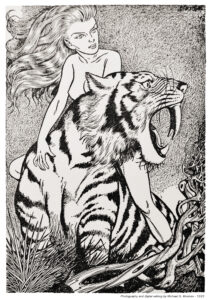
______________________________
And, for your consideration, here’s the blurb from the dust-jacket…
DARKER THAN YOU THINK
By JACK WILLIAMSON
WHEN the Mondrick expedition returns from the Gobi Desert with an iron-bound chest and a haunting burden of dread, it brings with it proof of a warfare that has continued for unnumbered centuries – warfare hitherto buried deep in the subconscious of the human race.
Mankind, according to Dr. Mondrick, is a hybrid breed. The blood of Homo sapiens is diluted with a darker stream. In your veins, and in ours, so the Mondrick theory claims, ebbs and flows an evil tide. Perhaps you, the individual reader, are only one part in a thousand inhuman, or one in ten thousand. But you aren’t all human… Few men are aware of their own alien strain. We know more about the distant stars than we do of our own tragic plight. But every man now living has inherited some of the black taint of Homo lycanthropus. And there are throwbacks! Or so, at least, Dr. Mondrick suggests.
Will Barbee, reporter, covering the return of the Mondrick expedition for his newspaper, meets gorgeous April Bell who claims to be a report for a rival sheet. He gets a story stranger by far than he expects – and becomes involved in a desperate drams of dark human conflict and darker victory.
In “Darker Than You Think”, Jack Williamson has written a story which is peculiarly disturbing, for despite its fantasy it is convincing; and it accounts for a great many things that otherwise are difficult to explain – and for some things that otherwise can scarcely be explained at all. The primitive belief in witchcraft is absolutely universal. It exists in communities, from Europe to Tasmania, which have no cultural connection whatever. “Darker Than You Think” offers the most convincing explanation of witchcraft ever set forth.
In this strange study of our own troubled times and our own secret lives, Williamson has skillfully blended such seemingly unrelated subjects as lycanthropy and witchcraft with parapsychology and psychokinesis. He has written a story which may well be unique, embracing a theory new to anthropology, and an interpretation of human behavior never anticipated by psychologists. But above all, he has produced an enthralling story.
And, who knows? The time, indeed, may already be later than you think, and man’s future darker! xxxxx

Having its first appearance in the December, 1940 issue of Unknown, Williamson’s novel was accompanied by nine illustrations in the pulp’s American edition, but in the British edition, only one, the latter being the same ominous-looking-cloaked-skeleton which opens the tale in the American version. By Edd Cartier, these illustrations are all to the same high standard of imagination and technical quality typical of his work
But, only two really stand out in terms of symbolism and mythic power: April and tiger Will, and, April riding a bat-bird-like-something-or-other. Downloaded from the Pulp Magazine Archive and then edited slightly, here they are, below:
Unknown (page 43)

__________
____________________
______________________________
____________________
__________
Unknown (page 84)
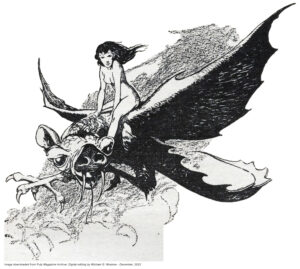

“The Tyger”, by William Blake
Tyger Tyger, burning bright,
In the forests of the night;
What immortal hand or eye,
Could frame thy fearful symmetry?
In what distant deeps or skies,
Burnt the fire of thine eyes?
On what wings dare he aspire?
What the hand, dare sieze [sic] the fire?
And what shoulder, & what art,
Could twist the sinews of thy heart?
And when thy heart began to beat,
What dread hand? & what dread feet?
What the hammer? what the chain,
In what furnace was thy brain?
What the anvil? what dread grasp,
Dare its deadly terrors clasp!
When the stars threw down their spears
And water’d heaven with their tears:
Did he smile his work to see?
Did he who made the Lamb make thee?
Tyger Tyger burning bright,
In the forests of the night:
What immortal hand or eye,
Dare frame thy fearful symmetry?

Here’s Collier Books’ 1989 imprint of Darker Than You Think, which features cover art by Jill Bauman. Through a coincidence most curious – if not magical – I discovered this near-pristine copy in a used bookstore (yes, those still exist). I read it in about three days (off and on, not continuously!), and it sparked the creation of this post.
Bauman’s cover art is very effective in casting the creatures central to the story in silhouette, with April Bell implied at right, rather than depicting them in full detail. A lack of definition lets one’s imagination run a little, um, er, uh, wilder?! – shall we say?


Of the darkness?…
“Darker Than You Think”, Unknown, December, 1940, via…
… Pulp Magazine Archive
American Edition (contains all illustrations)
British Edition (lead illustration only)
… Wikipedia
… GoodReads
… Fantasy Literature
… Internet Speculative Fiction Database
… WorldCat
Shapeshifters, at…
… The Encyclopedia of Science Fiction
“The Tyger”, by William Blake, at…
… Wikipedia
William Blake (himself!), at…
… Wikipedia
A.J. (Andrew Julian) Donnell, at…
… Internet Speculative Fiction Database






